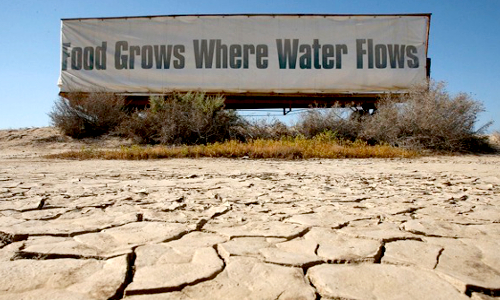The bold headline of a recent Los Angeles Times editorialby the hydrologist Jay Famiglietti starkly warned: “California has about one year of water left. Will you ration now?” The write-up quickly made the social media rounds, prompting both panic and the usual blame game: It’s because of the meat eatersor the vegan almond-milkdrinkers or the bottled-waterguzzlers or the Southern California lawn soakers.
California’s water losshas been terrifying. But people everywhere should be scared, not just Californians, because this story goes far beyond state lines. It is a story of global climate change and industrial agriculture. It is also a saga that began many decades ago—with the early water wars of the 1930s immortalized in the 1974 Roman Polanski film “Chinatown.”
When my family first moved to the Los Angeles area, we spent years adjusting our lifestyle to be more in line with our values. Ten years ago, we stopped watering our lawn and eventually replaced the lawn with plants that were drought-tolerant or native to California. Three years ago, we installed solar panels on our roofs. Last year, we diverted our laundry runoff to our vegetable garden and fruit trees through a graywater system. We have replaced all our toilets with dual-flush systems to take advantage of local rebates, and we practiceresponsible flushing. We almost never wash our cars, and we shower less often in the winter. We are investigating rainwater barrels in our latest effort to be responsible stewards of our water. Yet none of our efforts to be an example to others have done anything other than make us feel morally self-righteous enough to wag our fingers at water wasters.
California’s water resources are being mismanaged, according to Janet Redman, director of the Climate Policy Program at the Institute for Policy Studies, a progressive think tank. “The management of water from California’s historic aquifer and snow and rivers and lakes doesn’t match the use right now,” Redman told me in an interviewon my show, “Uprising.”It’s a big understatement.
Even though Gov. Jerry Brown just imposed a series of mandatory water-conservation measuresin response to the emergency, most of those measures are aimed at individual users and restaurants. While it is crucial for residents to stop wasting water on the utterly useless tasks of car washing and lawn watering, “residential use in California is about 4 percent,” Redman told me. “Eighty percent is for agriculture.”
The truth is that California’s Central Valley, which is where the vast majority of the state’s farming businesses are located, is a desert. That desert is irrigated with enough precious water to artificially sustain the growing of one-third of the nation’s fruits and vegetables, a $40 billion industry.

